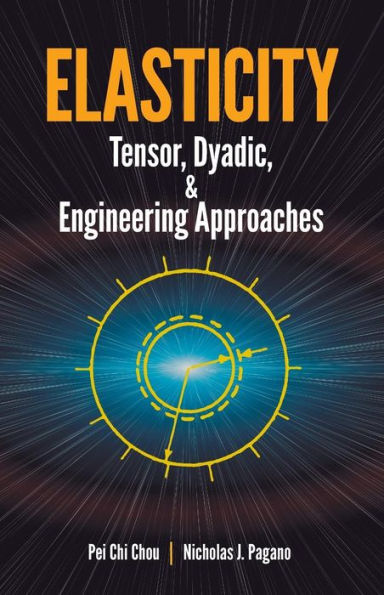5
1

Elasticity: Tensor, Dyadic, and Engineering Approaches
320
by Pei Chi Chou, Nicholas J. Pagano
Pei Chi Chou

Elasticity: Tensor, Dyadic, and Engineering Approaches
320
by Pei Chi Chou, Nicholas J. Pagano
Pei Chi Chou
Paperback(Reprint)
$16.95
-
PICK UP IN STORECheck Availability at Nearby Stores
Available within 2 business hours
Related collections and offers
16.95
In Stock
Overview
Written for advanced undergraduates and beginning graduate students, this exceptionally clear text treats both the engineering and mathematical aspects of elasticity. It is especially useful because it offers the theory of linear elasticity from three standpoints: engineering, Cartesian tensor, and vector-dyadic. In this way the student receives a more complete picture and a more thorough understanding of engineering elasticity. Prerequisites are a working knowledge of statics and strength of materials plus calculus and vector analysis.
The first part of the book treats the theory of elasticity by the most elementary approach, emphasizing physical significance and using engineering notations. It gives engineering students a clear, basic understanding of linear elasticity. The latter part of the text, after Cartesian tensor and dyadic notations are introduced, gives a more general treatment of elasticity. Most of the equations of the earlier chapters are repeated in Cartesian tensor notation and again in vector-dyadic notation. By having access to this threefold approach in one book, beginning students will benefit from cross-referencing, which makes the learning process easier.
Another helpful feature of this text is the charts and tables showing the logical relationships among the equations -- especially useful in elasticity, where the mathematical chain from definition and concept to application is often long. Understanding of the theory is further reinforced by extensive problems at the end of each chapter.
The first part of the book treats the theory of elasticity by the most elementary approach, emphasizing physical significance and using engineering notations. It gives engineering students a clear, basic understanding of linear elasticity. The latter part of the text, after Cartesian tensor and dyadic notations are introduced, gives a more general treatment of elasticity. Most of the equations of the earlier chapters are repeated in Cartesian tensor notation and again in vector-dyadic notation. By having access to this threefold approach in one book, beginning students will benefit from cross-referencing, which makes the learning process easier.
Another helpful feature of this text is the charts and tables showing the logical relationships among the equations -- especially useful in elasticity, where the mathematical chain from definition and concept to application is often long. Understanding of the theory is further reinforced by extensive problems at the end of each chapter.

Product Details
| ISBN-13: | 9780486669588 |
|---|---|
| Publisher: | Dover Publications |
| Publication date: | 01/17/1992 |
| Series: | Dover Civil and Mechanical Engineering Series |
| Edition description: | Reprint |
| Pages: | 320 |
| Product dimensions: | 5.50(w) x 8.50(h) x (d) |
Table of Contents
PREFACEINTRODUCTION
1 ANALYSIS OF STRESS
1.1 Introduction
1.2 "Body Forces, Surface Forces, and Stresses"
1.3 Uniform State of Stress (Two-Dimensional)
1.4 Principal Stresses
1.5 Mohr's Circle of Stress
1.6 State of Stress at a Point
1.7 Differential Equations of Equilibrium
1.8 Three-Dimensional State of Stress at a Point
1.9 Summary
Problems
2 STRAIN AND DISPLACEMENT
2.1 Introduction
2.2 Strain-Displacement Relations
2.3 Compatibility Equations
2.4 State of Strain at a Point
2.5 General Displacements
2.6 Principle of Superposition
2.7 Summary
Problems
3 STRESS STRAIN RELATIONS
3.1 Introduction
3.2 Generalized Hooke's Law
3.3 Bulk Modulus of Elasticity
3.4 Summary
Problems
4 FORMULATION OF PROBLEMS IN ELASTICITY
4.1 Introduction
4.2 Boundary Conditions
4.3 Governing Equations in Plane Strain Problems
4.4 Governing Equations in Three-Dimensional Problems
4.5 Principal of Superposition
4.6 Uniqueness of Elasticity Solutions
4.7 Saint-Venant's Principle
4.8 Summary
Problems
5 TWO-DIMENSIONAL PROBLEMS
5.1 Introduction
5.2 Plane Stress Problems
5.3 Approximate Character of Plane Stress Equations
5.4 Polar Coordinates in Two-Dimensional Problems
5.5 Axisymmetric Plane Problems
5.6 The Semi-Inverse Method
Problems
6 TORSION OF CYLINDRICAL BARS
6.1 General Solution of the Problem
6.2 Solutions Derived from Equations of Boundaries
6.3 Membrane (Soap Film) Analogy
6.4 Multiply Connected Cross Sections
6.5 Solution by Means of Separation of Variables
Problems
7 ENERGY METHODS
7.1 Introduction
7.2 Strain Energy
7.3 Variable Stress Distribution and Body Forces
7.4 Principle of Virtual Work and the Theorem of Minimum Potential Energy
7.5 Illustrative Problems
7.6 Rayleigh-Ritz Method
Problems
8 CARTESIAN TENSOR NOTATION
8.1 Introduction
8.2 Indicial Notation and Vector Transformations
8.3 Higher-Order Tensors
8.4 Gradient of a Vector
8.5 The Kronecker Delta
8.6 Tensor Contraction
8.7 The Alternating Tensor
8.8 The Theorem of Gauss
Problems
9 THE STRESS TENSOR
9.1 State of Stress at a Point
9.2 Principal Axes of the Stress Tensor
9.3 Equations of Equilibrium
9.4 The Stress Ellipsoid
9.5 Body Moment and Couple Stress
Problems
10 "STRAIN, DISPLACEMENT, AND THE GOVERNING EQUATIONS OF ELASTICITY"
10.1 Introduction
10.2 Displacement and Strain
10.3 Generalized Hooke's Law
10.4 Equations of Compatibility
10.5 Governing Equations in Terms of Displacement
10.6 Strain Energy
10.7 Governing Equations of Elasticity
Problems
11 VECTOR AND DYADIC NOTATION IN ELASTICITY
11.1 Introduction
11.2 Review of Basic Notations and Relations in Vector Analysis
11.3 Dyadic Notation
11.4 Vector Representation of Stress on a Plane
11.5 Equations of Transformation of Stress
11.6 Equations of Equilibrium
11.7 Displacement and Strain
11.8 Generalized Hooke's Law and Navier's Equation
11.9 Equations of Compatibility
11.10 Strain Energy
11.12 Governing Equations of Elasticity
Problems
12 ORTHOGONAL CURVILINEAR COORDINATES
12.1 Introduction
12.2 Scale Factors
12.3 Derivatives of the Unit Vectors
12.4 Vector Operators
12.5 Dyadic Notation and Dyadic Operators
12.6 Governing Equations of Elasticity in Dyadic Notation
12.7 Summary of Vector and Dyadic Operators in Cylindrical and Spherical Coordinates
Problems
13 DISPLACEMENT FUNCTIONS AND STRESS FUNCTIONS
13.1 Introduction
13.2 Displacement Functions
13.3 The Galerkin Vector
13.4 The Solution of Papkovich-Neuber
13.5 Stress Functions
Problems
References
INDEX
From the B&N Reads Blog
Page 1 of
